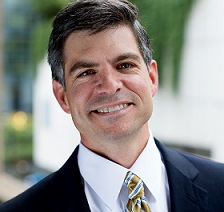 Otolaryngologist Dr. M. Boyd Gillespie discusses bringing sialendoscopy to the ambulatory surgery center setting.
Otolaryngologist Dr. M. Boyd Gillespie discusses bringing sialendoscopy to the ambulatory surgery center setting. M. Boyd Gillespie, MD, MSc, board-certified otolaryngologist and sleep medicine physician with the Medical University of South Carolina in Charleston, focuses a large portion of his practice on diseases of the thyroid and salivary glands. Here Dr. Gillespie discusses the logistics and opportunity for bringing sialendoscopy to the ambulatory surgery center.
Question: What ENT advances in the outpatient setting have you observed?
Dr. Boyd Gillespie: Half of my practice is dedicated to head and neck surgery, including tumors and diseases of the thyroid and salivary glands. The other half of my practice is sleep medicine and surgery. Head and neck surgery has traditionally been performed in the hospital setting, however, with smaller incisions and better technology, physicians are more confident that patients undergoing certain head and neck procedures such as thyroidectomy, parathyroidectomy and salivary gland excision, can be effectively treated as outpatients in the ambulatory surgery center.
Q: Can treatment for salivary gland conditions be brought to the ASC?
BG: In regards to salivary gland conditions, my main interest lies with patients who have recurrent swelling and pain in these glands. A variety of disorders can cause this, though in about 50 percent of cases salivary stones are the underlying cause. Other causes include salivary scar tissue, autoimmune diseases and radioiodine damage to the salivary glands. Physicians can certainly treat benign salivary disorders in the ASC.
Q: What does an ASC need to be able to offer this type of treatment?
BG: Sialendoscopy requires specialized equipment. Any surgery center that already offers other ENT services would be good candidates for adopting the procedure. These facilities will already have the necessary cameras and monitors associated with sinus and other ENT surgery. The only additional equipment would be the salivary endoscopes.
These scopes typically come in a range of 0.8mm to 1.6mm in diameter. The scopes allow physicians to enter the natural orifices of the salivary glands, remove any areas of obstruction and stones, flush out debris, and instill medicine.
Q: Why is sialendoscopy a good candidate for the outpatient environment?
BG: We are able to successfully treat about 90 percent of patients with sialendoscopy. Previously, we would have to remove the gland. With this technique we can alleviate symptoms without invasive action which is ideal for the ambulatory setting.
The entire procedure takes an hour to two hours to perform under a brief general anesthesia. It puts no major nerves at risk, avoids external incisions, and patients do not need an overnight stay. Post-operative pain and wound care are minimal, and patients can resume a diet immediately.
Q: How long have you been performing this procedure?
BG: I have been doing this procedure since 2008. The technique first began in Europe in the early 1990s. U.S. physicians began learning this procedure in the mid 2000s and from there started to build large referral practices.
I now do four cases a week on average, or approximately 200 patients a year. The early adopters of this technique were mostly academic surgeons who are dedicated to training other physicians to perform the procedure. One major manufacturer makes the scopes, but another leading medical device company has begun to create disposable instrumentation for sialendoscopy. These new disposable dilators and guide wires have really advanced our ability to take care of patients with chronic obstructive salivary disorders.
Q: What is the learning curve for ENT physician interested in adopting this technique?
BG: We recommend any physician that wants to learn how to do sialendoscopy take a hands-on course. These courses generally take one to two days and involve lectures as well as animal or human cadaver models to grow accustomed to the anatomy. After being introduced to the scope, it generally takes 10 to 20 patients to become proficient and 50 patients to become an expert. A physician new to the procedure should schedule a three hour block of time so they are not rushed. Once physicians are comfortable, the procedure can easily be done within an hour and a half.
Q: Which ASCs should consider adding this procedure?
BG: Salivary disorders are not uncommon, but not overly abundant. About one in 10,000 people a year are affected. Some cases will resolve immediately and others will require surgical management. ASCs that should consider adding this procedure would be located in a major metropolitan area that has a significant patient population.
Q: What are the start-up costs involved with bringing sialendoscopy to an ASC?
BG: A single set of scopes is around $30,000. If a center plans on being busy, they will need two sets of scopes, which is a $60,000 investment. ASCs in a large metropolitan area where no such program exists stand to become busy very quickly. The return on investment is good. Once you have bought the equipment, it will pay for itself relatively quickly.
Q: What are the benefits of adding sialendoscopy as an ASC procedure line?
BG: Sialendoscopy is a fairly specialized procedure. Though not every center will want to offer it, those that do and find success will be seen as salivary experts. It is likely these physicians and ASCs will see an increase in referrals for other salivary gland disorders.
From the patient's perspective, they are spared salivary gland removal. Sialendoscopy improves cosmetics, function and recovery time. There is less time away from work and less cost involved. Sialendoscopy is about 25 percent less expensive than gland removal.
More Articles on ASC Core Specialties:
Strategies for Growing Patient Volume: 4 Gastroenterologists Discuss
8 Physicians on Advantages of ASCs for Sports Medicine
5 Ophthalmologists on Top Issues in the Field
